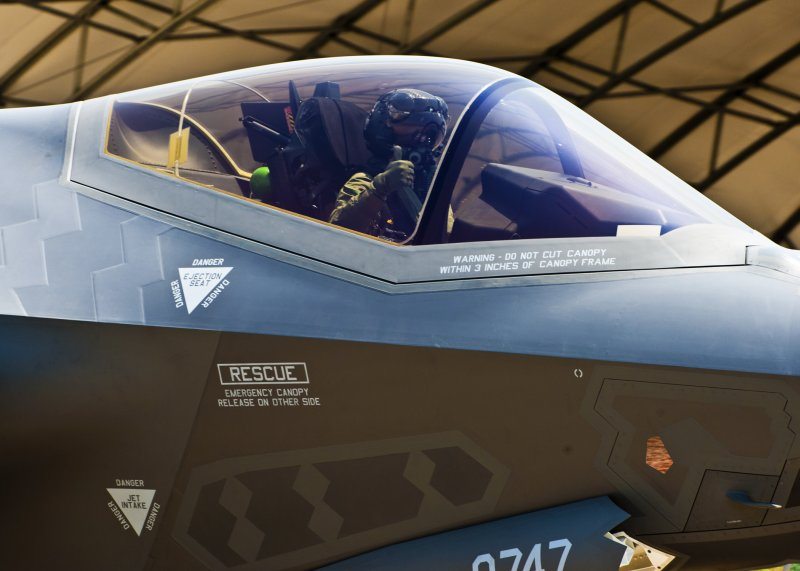With the arrival of the joint strike fighter, the military continues setting the historic milestones for the worldwide aviation industry in preparing the first F-35 Lightning II pilots.
Lt. Col. Eric Smith became a part of history himself recently as the first Airman to fly the new stealth fighter for his service, an honor he said he never expected during his 16 years in an Air Force flight suit.
“It all came to light six months ago,” said Smith, who moved to the 33rd Fighter Wing in 2009 after spending two years as a developmental test pilot with the 46th Test Wing here. “I was picked because of my test background and the training I had in 2005.”
At Eglin, he was able to apply his experience flying A-10 Thunderbolt IIs and F-16 Fighting Falcons to the test mission before transferring over to the 33rd FW just as the wing ended its era of F-15 Eagle air dominance.
“Taking off in the F-35 for the first time, I experienced an adrenaline rush like I hadn’t felt since I flew an A-10 for the first time,” Smith said. “The difference this time is the fact that the F-35 is such a new airplane. If something goes wrong, you may be the first pilot to deal with the problem with only your previous fighter experience to rely on. Fortunately, my first flight went off without a hitch.”
As an A-10 pilot, he knew the risks of flying in a single seat aircraft.
“Your first flight in an unfamiliar airplane means it’s also your first solo flight,” he said. “Once you leave the ground you have the next two hours to figure out how to safely land the jet.”
The pilot spent a month flying F-35 test missions to ensure the Air Force’s smooth transition from developmental test flights at Edwards Air Force Base, Calif., to the training flights that are scheduled to begin here by the end of the year.
Air Force Materiel Command’s training program at Edwards is designed for test pilot school graduates with flight hours in a variety of airframes, Smith said. The pilot completed courses in F-35 academics, emergency procedures via simulator, engine run and high-speed taxi with three F-35 flights, while an instructor pilot flew in a chase plane.
“I’m extremely thrilled to be honored as the first Air Education and Training Command F-35 instructor pilot,” Smith said. “It means a lot to me but more for the 33rd FW who can now execute the training plan they have been working on for two years. We have a great team and will soon begin training F-35 pilots and maintainers.”
Smith will oversee flight operations of the initial F-35 pilot cadre as the director of operations for the 58th Fighter Squadron. He said the training program here will be more robust than what he needed to qualify in the F-35.
A student pilot at Eglin will receive approximately 200 hours of academics, 14 simulators, a high-speed taxi and six flights in the airplane before deemed qualified. Technological advances in virtual reality pilot and maintenance training is the biggest difference 33rd FW students will experience with the military’s latest weapons system.
“I’ve got 80 hours in the simulator and only logged nine actual flying hours,” Smith said. “That is a testament to how good the simulator is. Everything is digital.”
Other new devices to be introduced are the F-35’s unique set of pilot flight equipment, including an anti-gravity suit, a jacket with integral arm restraints and a helmet-mounted display system.
“It forced me to change all of my habits when it came to ‘strapping on’ the jet (for the first time),” Smith said. “The HMD is an extremely complex piece of equipment that uses two projectors to display independent images on the pilot’s display visor.”
The pilot said it took approximately six hours to fit and focus the helmet that will eventually give pilots a full 360-degree view around them in flight using cameras located around the exterior of the aircraft.
The F-35 helmet-mounted display system provides a combination of impact protection, heads-up display information and night vision, combining legacy aircraft systems into a single unit, according to officials with Lockheed Martin.
Smith’s experiences will be shared among an integrated team of 33rd FW Nomads, who now prepare for a pipeline of students from three different branches of service.
With the success of 5th generation stealth aviation training at the wing, the F-35 will provide air dominance to the U.S. and its coalition partners for the next several decades, he said.
As for Smith, he’ll continue to support the Air Force test mission at Edwards temporarily and return to Eglin as a senior leader for a squadron to which he personally delivered the first aircraft.











